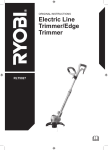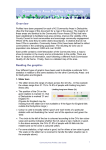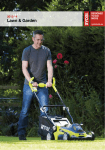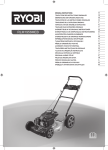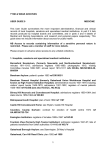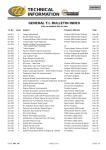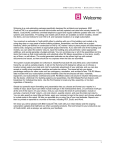Download Ryobi RLM1956MEB Operator`s manual
Transcript
ORIGINAL INSTRUCTIONS Petrol Lawn Mower RLM1956MEB Important! It is essential that you read the instructions in this manual before operating this machine. Subject to technical modifications. English General safety rules  WARNING To reduce the risk of injury, the user must read and understand the operator’s manual. slip and fall accident. ■■ Plan your mowing pattern to avoid discharge of material toward roads, public pavements, bystanders and the like. Also, avoid discharging material against a wall or obstruction, which may cause the material to ricochet back toward the operator. Work area safety  WARNING Do not attempt to operate this mower until you have read thoroughly and understood completely all instructions, safety rules, etc., contained in this manual. Failure to comply may result in accidents involving electric shock, fire, and/or serious personal injury. Personal safety ■■ This lawn mower is capable of amputating hands and feet, and throwing objects. Failure to observe all safety instructions could result in serious injury or death. ■■ Never allow children or people with reduced physical, sensory, mental capabilities or unfamiliar with the instructions to use the mower. Local regulations may restrict the age of the operator. Children should be adequately supervised to ensure they don’t play with the mower. ■■ Ensure before each use that all controls and safety devices function correctly. Do not use the tool if the “off” switch does not stop the engine. ■■ Stay alert, watch what you are doing, and use common sense when operating the lawn mower. Do not operate the mower while tired or under the influence of drugs, alcohol, or medication. A lapse in concentration while operating the machine may result in serious personal injury. ■■ Wear heavy, long trousers, long sleeves, slip-resistant foot protection, and gloves. Do not wear loose fitting clothing, short trousers, sandals, or go barefoot. ■■ Wear ear protection and safety glasses at all times while operating the machine. Use face mask if operation is dusty. ■■ Use of hearing protection reduces the ability to hear warnings (shouts or alarms). The operator must pay extra attention to what is going on in the working area. ■■ Operating similar tools nearby increases both the risk of hearing injury and the potential for other persons to enter your working area. ■■ Always be sure of your footing, especially on slopes. Keep firm footing and balance. Do not overreach. Overreaching can result in loss of balance. ■■ Walk, never run. ■■ Mow across the face of slopes, never up and down. Exercise extreme caution when changing direction on slopes. ■■ Do not mow near drop-offs, ditches, excessively steep slopes, or embankments. Poor footing could cause a ■■ Keep all bystanders, children, and pets at least 15 m away from work area. If anyone enters this area, stop the machine. ■■ Do not operate in poor lighting. The operator requires a clear view of the work area to identify potential hazards. ■■ Do not operate the machine in explosive atmospheres, such as in the presence of flammable liquids, gases or dust. The tool create sparks which may ignite the dust or fumes. ■■ Objects struck by the lawn mower blade can cause severe injuries to persons. Thoroughly inspect the area where the machine is to be used and remove all rocks, sticks, metal, wire, bones, toys, or other foreign objects. ■■ Do not operate the machine in wet grass or in the rain. ■■ Keep in mind that the operator or user is responsible for accidents or hazards occurring to other people or their property. ■■ Tragic accidents can occur if the operator is not alert to the presence of children. Children are often attracted to the machine and the mowing activity. Never assume that children will remain where you last saw them. ■■ Keep children out of the mowing area and under the watchful care of a responsible adult other than the operator. ■■ Use extra care when approaching blind corners, shrubs, trees, or other objects that may block your view. ■■ Keep work area clean. Cluttered or dark areas invite accidents. Lawn mower safety warnings ■■ Before using, always visually inspect to ensure blades, blade bolts, and cutter assembly are not worn or damaged. Check the product before each use and frequently. ■■ Replace worn or damaged blades and bolts in sets to preserve balance. ■■ Check all nuts, bolts, and screws at frequent intervals for proper tightness to be sure the equipment is in safe working condition. ■■ Check the grass catcher frequently for wear , holes or deterioration. This can cause objects to be thrown towards the operator. ■■ Replace worn or damaged parts before operating the product. ■■ Never operate the mower if the presence control lever, when released, does not stop the engine. ■■ The lawn mower shall not be operated without either 1 English entire grass catcher or self-closing discharge opening guard in place. ■■ Do not use the lawn mower when there is a risk of lightning. ■■ Do not force the product. It will do the job better and safer at the speed for which it was designed. ■■ Do not overload your mower. Mowing long thick grass may cause the motor speed to drop, or the power to cut out. When mowing in long thick grass a first cut with the cutting height set higher will help reduce the load. See adjusting the blade height. ■■ Stop the blade when crossing gravel surfaces. ■■ Do not pull the mower backward unless absolutely necessary. If you must back the machine away from a wall or obstruction, first look down and behind to avoid tripping or pulling the machine over your feet. ■■ Stop the blade(s) if the machine has to be tilted for transportation when crossing surfaces other than grass, and when transporting the machine to and from the area to be mowed. ■■ Never operate the machine with defective guards or shields, or without safety devices, for example deflectors and/or grass collector, in place. ■■ Start the engine carefully according to instructions and keep hands and feet away from cutting area. Keep clear of the discharge opening at all times. ■■ Never pick up or carry a lawn mower while the engine is running. ■■ Avoid holes, ruts, bumps, rocks, property stakes, or other hidden objects. Uneven terrain could cause a slip and fall accident. ■■ When not in use, mower should be stored in a wellventilated, dry, locked up place-out of the reach of children. ■■ Follow manufacturer’s instructions for proper operation and installation of accessories. Only use accessories approved by the manufacturer. ■■ Do not operate the engine in a confined space where dangerous carbon monoxide fumes can collect. ■■ Do not change the engine governor settings or overspeed the engine. ■■ Do not tilt the lawn mower when starting the engine or whilst the engine is running. This exposes the blade and increases the probability of objects being thrown. ■■ Do not start the engine when standing in front of the discharge chute. ■■ Stop the engine, disconnect the spark plug wire, and wait until the blade comes to a complete stop and allow it cool before for the below case: ●● whenever you leave the product unattended ●● before cleaning a blockage or unclogging chute ●● before checking, cleaning or working on the product ●● after striking a foreign object; inspect the appliance for damage and make repairs as necessary before restarting and operating the machine. 2 ●● before clearing the grass catcher ■■ If the product starts to vibrate abnormally (check immediately) ●● inspect for damage ●● replace or repair any damaged parts ●● check for and tighten any loose parts ■■ If the machine strikes a foreign object, follow these steps: ●● Stop the mower and disconnect the spark plug wire. ●● Thoroughly inspect the mower and grass catcher for any damage. ●● Repair any damage before restarting and continuing to operate the mower. ■■ Allow engine to cool before storing in any enclosure. ■■ To reduce the risk of fire, keep the engine, silencer, and petrol storage area free of grass, leaves, and excessive grease. ■■ If the fuel tank has to be drained, this should be done outdoors. ■■ Disconnect the spark plug before making any adjustment, transporting, or storing the lawn mower. Such preventive safety measures reduce the risk of starting the product accidentally. ■■ This machine is extremely noisy and permanent hearing loss or damage may result if precautions to limit your exposure, reduce noise and wear hearing protection are not strictly adhered to. Service ■■ Service on the product must be performed by qualified repair personnel only. Service or maintenance performed by unqualified personnel could result in a risk of injury to the user, or damage to the machine. ■■ When servicing, use only original manufacturer’s replacement parts. Use of unauthorised parts may create a risk of serious injury to the user, or damage to the product. NOTE: Only perform the tasks listed in this manual. For other service or repair, it should be done by a qualified person. Save this manual for future reference. Refer to them frequently and use them to instruct others who may use this product. If you lend someone this unit, lend them these instructions also. Symbol Some of the following symbols may be used on this product. Please study them and learn their meaning. Proper interpretation of these symbols will allow you to operate the product better and safer. Precautions that involve your safety. English To reduce the risk of injury, user must read and understand operator’s manual before using this product. Hold the power lever down against the handle. Wear eye and ear protection. Pull the starter cord until the engine runs. Keep all body parts and clothing clear of any belts or other moving parts. Remove objects that could be thrown by the rotating blade. STOP Keep bystanders a safe distance away from the machine. To avoid injury, stay away from moving parts at all times. Fuel and its vapours are explosive and can cause severe burns or death. Fuel and its vapors are extremely flammable and explosive. Fire can cause severe burns or death. Use unleaded petrol intended for motor vehicle use with an octane rating of 87 [(R + M)/2] or higher. Danger! Keep hands and feet away. Beware of sharp cutting means -Before any repair work, remove the spark plug cable. Use SAE 30 or 10W-30 API-SJ weight oil. Conforms to all regulatory standards in the country in the EU where the product is purchased. Danger of Ricochet. Keep all bystanders at least 15 m away. EurAsian Conformity Mark To reduce the risk of injury or damage, avoid contact with any hot surface. Hold the power lever down against the handle to keep engine running. Release the power lever to stop the product. Do not smoke and stay away from open flames and sparks when filling fuel tank or when handling fuel. Guaranteed sound power level is 98 dB. Do not operate on inclines greater than 15˚. Mow across the face of slopes, never up and down. Do not touch the hot metal surface. Before using the product, remove the spark plug socket. Loosen fuel cap slowly to release pressure and to keep petrol from escaping around the cap. Stop the product. Intended use This product is intended for domestic lawn mowing. The cutting blade should rotate approximately parallel to the ground over which it is being wheeled. All four wheels should touch the ground while mowing. It is a pedestrian controlled walk behind mower. NOTE: The mower should never be operated with the wheels off the ground, it should not be pulled or ridden on. It should not be used to cut anything other than domestic grass lawns. Carefully pour petrol into the tank. Description Push the primer bulb 3 times. See figure 1. 1. Primer bulb 2. Spark plug boot 3. Oil cap/dipstick 4. Fuel cap 3 English 5. Height adjustment lever 6. Handle knob 7. Starter grip 8. Power lever 9. Rope guide knob 10.Air filter 11.Panel 12.Side discharge deflector 13.Pins 14.Side discharge door 15.Hooks of side discharge deflector 16.Side discharge door opening Assembly Unpacking This product requires assembly. ■■ Inspect the product carefully to make sure no breakage or damage occurred during shipping. ■■ If any parts are damaged or missing, please call your Ryobi service centre for assistance.  WARNING If any parts are damaged or missing do not operate this product until the parts are replaced. Using a product with damaged or missing parts could result in serious personal injury.  WARNING Do not attempt to modify the product or create accessories not recommended for use with the product. Any such alteration or modification is misuse and could result in a hazardous condition leading to possible serious personal injury.  WARNING The lawnmower safety systems or features shall not be tampered with or disabled.  WARNING Never attach or adjust any accessory while the mower is running. Failure to stop the engine may cause serious personal injury.  WARNING To prevent accidental starting that could cause serious personal injury, always disconnect the engine spark plug wire from the spark plug when assembling parts.  WARNING Never operate the mower without the proper safety devices in place and working. Never operate the mower with damaged safety devices. Operation of this product with damaged or missing parts could result in serious personal injury. Installation of the panel See figure 1a. 1. Use a wrench and socket set (not provided) with the bolts and nuts to secure the panel on the handle. Installation See figure 2. 1. Place handles in correct operating position and tighten handle knobs to secure. NOTE: Do not pinch the cable. 2. Place starter rope in guide on handle. 3. Install grass catcher or mulching plug. Setting blade height See figure 3. When shipped, the wheels on the mower are set to a low- cutting position. Before using the mower for the first time, adjust the cutting position to the height best suited for your lawn. The average lawn should be between 38 mm to 50 mm during cool months and between 50 mm and 76 mm during hot months. To set the blade height: ■■ To raise the blade height, grasp the height adjustment lever and move it toward the back of the mower. ■■ To lower the blade height, grasp the height adjustment lever and move it toward the front of the mower. Installing side discharge deflector (for side discharge operation) See figure 5. NOTE: When using the side discharge deflector, do not install the grass catcher. The mulching plug should remain installed. 1. Lift the side discharge door. 2. Align the hooks on the deflector with the hinge rod on the underside of the door. 3. Lower the deflector until the hooks are secured on the mulch door hinge rod. 4. Release the deflector and side discharge door. Operation Fuel and refuelling  WARNING Always handle petrol with care; it is highly flammable. 4 English ■■ Use fresh fuel. ■■ Store fuel in containers specifically designed for this purpose. ■■ Always refuel outdoors where there are no sparks and flames. Do not inhale fuel vapour. Do not smoke and stay away from open flames and sparks when filling fuel tank or when handling fuel. ■■ Do not let petrol or oil come in contact with your skin. ■■ Keep petrol and oil away from the eyes. If petrol or oil comes in contact with the eyes, wash them immediately with clean water. If irritation is still present, see a doctor immediately. ■■ Clean up spilled petrol immediately. WARNING Always shut off engine and allow it to cool for 5 minutes before refuelling. Never remove the cap of the fuel tank or add petrol to a machine with a running or hot engine. Move at least 9 m (30 ft) from refuelling site before starting the engine. Do not smoke. Failure to heed this warning could result in serious personal injury.  5. Reinstall the oil cap/dipstick and secure. To check engine oil: ■■ Be sure mower is level and area around oil cap/dipstick is clean. ■■ Remove the oil cap/dipstick. Wipe clean and reseat in oil fill hole but do not screw in. Filling the tank See figure 4.  To add engine oil: 1. Be sure mower is level and area around oil cap/dipstick is clean. 2. Remove the cap and seal from oil bottle. 3. Unscrew the oil cap/dipstick and remove. 4. Slowly add oil. Fill to the “Full” line on dipstick. Do not overfill. NOTE: When checking the oil level, seat the dipstick in the oil fill hole but do not screw in. WARNING Do not overfill. Fill the fuel tank to 25 mm below the top of the fuel neck. After fueling, never tilt the mower more than 25 degrees for this could result in fuel leakage and risk of fire, etc. 1. Clean surface around fuel cap to prevent contamination. 2. Loosen fuel cap slowly to release pressure and to keep fuel from escaping around the cap. Rest the cap on a clean surface. 3. Carefully pour petrol into the tank. Avoid spillage. 4. Clean and inspect the gasket, then replace all fuel and container caps securely. 5. Wipe up any fuel spillage. Move 9 m away from refuelling site before starting engine. NOTE: It is normal for smoke to be emitted from a new engine during and after first use. Adding/checking engine oil See figure 4. Engine oil has a major influence on engine performance and service life. For general, all-temperature use, SAE 10W-30 is recommended. Always use a 4-cycle motor oil that meets or exceeds the requirements for API service classification SJ. NOTE: Non-detergent or 2-cycle engine oils will damage the engine and should not be used. ■■ Remove the oil cap/dipstick again and check oil level. Add oil as needed. Starting or stopping the mower See figure 4.  WARNING Never start or run the engine inside a closed or poorly ventilated area; breathing exhaust fumes can kill. NOTE: Reduce the throttle setting during engine shut down. If the engine is provided with a shut-off valve, turn the fuel off at the conclusion of mowing. Starting the engine 1. Press the primer bulb 3 times. NOTE: This step is not usually necessary when starting an engine that has already run for a few minutes. 2. Hold the power lever bar down against the handle. 3. Pull the starter grip until the engine starts. Release the starter cord slowly so the rope does not snap back. NOTE: It may be necessary to repeat priming steps in cooler weather. In warmer weather, overpriming may cause flooding and engine will not start. If you do flood the engine, wait a few minutes before attempting to start and do not repeat priming steps. Stopping the engine Release the power lever and allow the engine to come to a complete stop. Mowing tips ■■ Make sure the lawn mower mowing area is clear of stones, sticks, wires, and other objects that could damage the lawn mower blades or engine. Such objects could be accidentally thrown by the mower in any direction and cause serious personal injury to the operator and others. ■■ For best performance, always cut off one-third or less of the total height of the grass. 5 English ■■ When cutting long grass, reduce walking speed to allow for more effective cutting and a proper discharge of the clippings. ■■ Do not cut wet grass, it will stick to the underside of the deck and prevent proper bagging or mulching of grass clippings. ■■ New or thick grass may require a higher cutting height and a narrower cutting path. ■■ Clean the underside of the mower deck after each use to remove grass clippings, leaves, dirt, and any other accumulated debris. Refer to “Cleaning the underside of the mower deck” section. Slope operation tips See figure 6. ■■ Slopes are a major factor related to slip and fall accidents that can result in severe injury. Operation on slopes requires extra caution. If you feel uneasy on a slope, do not mow it. For your safety, do not attempt to mow slopes greater than 15 degrees. The manufacturer recommends not to use the drive wheels when mowing on slopes. ■■ Mow across the face of slopes, never up and down. Exercise extreme caution when changing direction on slopes. ■■ Watch for holes, ruts, rocks, hidden objects, or bumps which can cause you to slip or trip. Tall grass can hide obstacles. Remove all objects such as rocks, tree limbs, etc., which could be tripped over or thrown by the blade.  WARNING If the machine is not maintained correctly then life span of the tool may be reduced, and inbuilt safety features may not function correctly, thus increasing the potential for serious injury. Keep the product in good working condition.  WARNING Before performing any maintenance, stop the mower, allow the blade to come to a complete stop, and disconnect the spark plug wire from the spark plug. Failure to heed this warning could result in serious personal injury.  WARNING When servicing, use only authorised replacement parts. Use of any other parts may create a hazard or cause product damage. General maintenance You may make adjustments and repairs described here. For other repairs, contact the authorised service agent. ■■ Always be sure of your footing. A slip and fall can cause serious personal injury. If you feel you are losing your balance, release the power lever immediately. ■■ Avoid using solvents when cleaning plastic parts. Most plastics are susceptible to damage from various types of commercial solvents and may be damaged by their use. Use clean cloths to remove dirt, dust, oil, grease, etc. ■■ Do not mow near drop-offs, ditches, or embankments; you could lose your footing or balance. ■■ Periodically check all nuts and bolts for proper tightness to ensure safe operation of the mower.  WARNING Use extreme caution when lifting or tilting the machine for maintenance, cleaning, storage or transportation, the blade is sharp, even though the engine is shut off, the blades can still be moved. keep all body parts away form the blade whilst it is exposed. Maintenance  WARNING After releasing the power lever, regularly check if the blade stops in 3 seconds. 6 ■■ Remove any buildup of grass and leaves on or around the engine and engine cover. Wipe the mower clean with a dry cloth occasionally. Do not use water. ■■ Check the grass catcher frequently for wear or deterioration.  WARNING Do not at any time let brake fluids, gasoline, petroleumbased products, penetrating oils, etc., come in contact with plastic parts. Chemicals can damage, weaken, or destroy plastic which may result in serious personal injury. Lubrication All of the bearings in this product are lubricated with a sufficient amount of high grade lubricant for the life of the unit under normal operating conditions. Therefore, no further bearing lubrication is required. English  WARNING Always protect hands by wearing heavy gloves and/or wrapping the cutting edges of the blade with rags and other material when performing blade maintenance. Contact with the blade could result in serious personal injury. Replacing the cutting blade See figure 7. Be careful during adjustment of machine to prevent entrapment of fingers between moving blades and fixed parts of machine. For best results, the mower blade must be kept sharp. Replace a bent or damaged blade immediately.  WARNING Only use replacement blades approved by the manufacturer of your mower. Using a blade not approved by the manufacturer of your mower is hazardous and could result in serious injury, damage your mower, and void your warranty.  WARNING Drain the fuel first before tilting the mower to replace the blade. 1. Stop the engine and disconnect the spark plug wire. Allow blade to come to a complete stop. 2. Turn the mower on its side (carburetor facing up). 3. Wedge a block of wood between the blade and mower deck to prevent the blade from turning. ●● Installing: See figure 7a. ●● Removing: See figure 7b. 4. Using a 9/16-in. wrench or socket (not provided), loosen the blade bolt by turning the bolt in a counterclockwise direction as viewed from the bottom of the mower. 5. Remove the blade bolt, lock washer, flat washer, and blade. 6. Place the new blade on the shaft. Make sure it is installed with the curved ends pointing up toward the mower deck and not down toward the ground. 7. Replace the flat washer, lock washer, and blade bolt on the shaft. Finger tighten the bolt by turning in a clockwise direction as viewed from the bottom of the mower. NOTE: Make certain all parts are replaced in the exact order in which they were removed. 8. Torque the blade bolt down using a torque wrench (not provided) to ensure the bolt is properly tightened. 9. The recommended torque for the blade bolt is 48–55 Nm (35–40 ft.lb.). NOTE: Do not sharpen the blades, replace with new item. Blades need to be properly balanced to avoid damage and personal injury. Cleaning the air filter See figure 8. For proper performance and long life, keep the air filter clean. 1. Remove the air filter cover by pushing down the latch while gently pulling out the cover. 2. Remove the air filter and clean it in warm soapy water. Rinse and let dry completely. 3. Apply a light coat of engine oil to the air filter, then squeeze it out using an absorbent cloth or paper towel. 4. Reinstall the air filter into the air filter base. 5. Replace and secure the air filter cover. NOTE: The filter should be replaced annually for best performance. Fuel cap WARNING A leaking fuel cap is a fire hazard and must be replaced immediately. The fuel cap contains a non-serviceable filter and a check valve. A clogged fuel cap will cause poor engine performance. If performance improves when the fuel cap is loosened, check valve may be faulty or clogged. Replace fuel cap if required. Changing the engine oil See figure 9. Ensure the fuel tank is completely empty before tipping the unit over otherwise fuel will leak out. Engine oil should be changed after every 25 hours of use. Change the oil while the engine oil is still warm, but not hot. This allows the oil to drain quickly and completely. 1. Remove the oil fill cap/dipstick. 2. Tip mower onto its side and allow oil to drain from the oil fill hole into an approved container. 3. Place mower upright and refill with oil following the instructions in the Adding/Checking Oil section. NOTE: Used oil should be disposed of at an approved disposal site. See your local oil retailer for more information. Maintaining the spark plug See figure 10. The spark plug must be properly gapped and free of deposits in order to ensure proper engine operation. To check: 1. Remove spark plug boot. 2. Clean any dirt from around base of spark plug. 3. Remove spark plug using a 13/16 in. spark plug socket (not provided). 4. Inspect spark plug for damage, and clean with a wire brush before reinstalling. If insulator is cracked or 7 English 5. 6. 7. 8. chipped, spark plug should be replaced. NOTE: If replacing, use the following recommended plugs are Torch E7RTC and NGK BPR6HS. Measure plug gap. The correct gap is 0.71 mm 0.79 mm. To widen gap, if necessary, carefully bend the ground (top) electrode. To lessen gap, gently tap ground electrode on a hard surface. Seat spark plug in position; thread in by hand to prevent cross-threading. Tighten with wrench to compress washer. If spark plug is new, use 1/2 turn to compress washer appropriate amount. If reusing old spark plug, use 1/8 to 1/4 turn for proper washer compression. NOTE: An improperly tightened spark plug will become very hot and could damage the engine. Reinstall spark plug boot. Replacing the wheels See figure 11.  WARNING Only use replacement wheels approved by the manufacturer of your mower. Using wheels not approved by the manufacturer of your mower is hazardous and could result in serious personal injury. 1. Stop the engine and disconnect the spark plug wire. Allow blade to come to a complete stop. 2. Remove the hub cap. 3. Remove the nut from the wheel axle, then remove the wheel. 4. Replace with new wheel and reinstall nut to secure. Storing the product When storing the mower for 30 days or more: ■■ If using fuel stabilizer, follow stabilizer manufacturer’s directions to add stabilizer to petrol in fuel tank. Run engine at least 10 minutes after adding stabilizer to allow the stabilizer to reach the carburetor.  WARNING Do not store the lawn mower with petrol in the tank inside a building where fumes may reach an open flame or spark. ■■ If not using fuel stabilizer, allow the engine to run until the mower is completely out of petrol. ■■ Once the engine has stopped, allow the blade to come to a complete stop and disconnect the spark plug wire. ■■ Turn the fuel valve to the closed position. ■■ Turn mower on its side (with carburetor facing up) and clean grass clippings that have accumulated on the underside of the mower deck. ■■ Clean the underside of the mower deck. 8 ■■ Wipe the mower clean with a dry cloth. ■■ Check all nuts, bolts, knobs, screws, fasteners, etc., for tightness. ■■ Inspect moving parts for damage, breakage, and wear. Have repairs made on any damaged or missing parts. ■■ Store the mower in a well-ventilated area that is clean, dry, and out of the reach of children. ■■ Do not store near corrosive materials such as fertilizer or rock salt. To lower the handle before storing: See figure 12. ■■ Loosen the starter rope guide knob. Remove starter rope from guide and allow to retract into engine. ■■ Fully loosen the handle knobs on the sides of the handle and fold the upper handle down. ■■ Push inward on each side of the lower handle, and lift the sides of the lower handle past the edges of the handle mounting brackets. ■■ Fold the lower handle forward, making sure not to bend or kink the control cables. Transportation ■■ Stop the machine, disconnect the spark plug wire and wait until the blade comes to a complete stop, and allow it to cool. ■■ Empty the fuel tank by running the engine till it stops. Empty oil by following instruction for changing oil. ■■ Secure the machine against movement or falling to prevent injury to persons or damage to the machine. English Troubleshooting Problem Handle not in correct position. Mower is not starting. Possible cause Solution Handle positioned incorrectly. Check to be sure that lower part of handle is pushed fully back and snapped into proper position. Handle knobs not tightened. Tighten handle knobs. No spark. Use spark tester to check for proper spark plug operation. No petrol. Check the fuel valve set to open. Fill mower with petrol. If mower still does not start, contact a servicing dealer. Engine is flooded. Wait 15 minutes, then try starting mower again. Do not prime before attempting to start. Starter rope pulls harder now than when new. Contact a servicing dealer. High grass, rear of mower housing and blade are dragging in heavy grass, or cutting height too low. Raise the cutting height. Wheel assembly needs cleaning. Clean wheel assembly. Blade is unbalanced. Replace the blade. Bent motor shaft. Stop the engine, disconnect the spark plug wire from the spark plug, and inspect for damage. Have it repaired by an authorised service center before restarting. Mower is not mulching properly. Wet grass clippings are sticking to the underside of the deck. Wait until the grass dries before mowing. Clean the underside of the mower deck. Mower is not bagging properly. Cutting height set too low. Raise the cutting height. Mower is hard to push. Mower is vibrating at higher speed. 9 English Specifications Engine 190cc OHV Power 3.2 kW@ 2800 rpm Drive system Push type Maximum operating engine speed (rotational frequency) 2,800/min (RPM) Cutting width 556 mm Height adjustments 5 positions 19 mm−76 mm Wheel size 20.3 cm front, 20.3 cm rear Vibration Level (in accordance with Annex G of EN ISO 5395-1:2013) 9.83 m/s², K=1.5 Noise emission level (in accordance with Annex F of EN ISO 5395-1:2013) Measured sound power level LwA 95.65 dB(A), K=1.2 dB Sound pressure level LpA 81.4 dB(A), K=3 dB Guaranteed sound power level 98.0 dB(A) Weight 34.2 kg Replacement parts Blade 10 099910003017 English MAINTENANCE SCHEDULE Before each use Check engine oil Every 12 months or after 300 hours of operation n Change engine oil Check air filter After 1st month Every 3 months Every 6 months or 20 hours of or 50 hours of or 100 hours operation operation of operation n n n Clean air filter n Change air filter n Replace the fuel filter n Check/adjust spark plug n Replace spark plug n Check/adjust idle speed n Check/adjust valve clearance* n Clean fuel tank and filter* Check fuel tube * These items should only be carried out by an authorised service center. n n 20141219v3 NOTE:Maintenance should be performed more frequently when the product is used in dusty areas. When the engine has exceeded the maximum figures specified in the table, maintenance should still be cycled according to the intervals of time or hours stated herein. 11 Guarantee In addition to any statutory rights resulting from the purchase, this product is covered by a guarantee as stated below. 1. The guarantee period is 24 months for consumers and commences on the date when the product was purchased. This date has to be documented by an invoice or other proof of purchase. The product is designed and dedicated to consumer and private use only. So there is no guarantee provided in case of professional or commercial use. 2. There is, in some cases (i.e. promotion, range of tools), a possibility to extend the warranty period over the period described above using the registration on the www.ryobitools.eu website. The eligibility of the tool is clearly displayed in stores and/or on packaging. The end user needs to register his/her newly-acquired tools online within 8 days from the date of purchase. The end user may register for the extended warranty in his country of residence if listed on the online registration form where this option is valid. Furthermore, end users must give their consent to the storage of the data which are required to enter online and they have to accept the terms and conditions. The registration confirmation receipt, which is sent out by e-mail, and the original invoice showing the date of purchase will serve as proof of the extended warranty. Your statutory rights remain unaffected. 3. The guarantee covers all defects of the product during the warranty period due to defaults in workmanship or material at the purchase date. The guarantee is limited to repair and/or replacement and does not include any other obligations including but not limited to incidental or consequential damages. The warranty is not valid if the product has been misused, used contrary to the instruction manual, or being incorrectly connected. This guarantee does not apply to: –– any damage to the product that is the result of improper maintenance –– any product that has been altered or modified –– any product where original identification (trade mark, serial number) markings have been defaced, altered or removed –– any damage caused by non-observance of the instruction manual –– any non CE product –– any product which has been attempted to be repaired by an non-qualified professional or without prior authorization by Techtronic Industries –– any product connected to improper power supply (amps, voltage, frequency) –– any product used with inappropriate fuel mixture (fuel, oil, percentage of oil) –– any damage caused by external influences (chemical, physical, shocks) or foreign substances –– normal wear and tear of spare parts –– inappropriate use, overloading of the tool –– use of non-approved accessories or parts –– carburettor after 6 months, carburettor adjustments after 6 months –– components (parts and accessories) subject to natural wear and tear, including but not limited to bump knobs, drive belts, clutch, blades of hedge trimmers or lawn mowers, harness, cable throttle, carbon brushes, power cord, tines, felt washers, hitch pins, blower fans, blower and vacuum tubes, vacuum bag and straps, guide bars, saw chains, hoses, connector fittings, spray nozzles, wheels, spray wands, inner reels, outer spools, cutting lines, spark plugs, air filters, gas filters, mulching blades, etc. 4. For servicing, the product must be sent or presented to a RYOBI authorized service station listed for each country in the following list of service station addresses. In some countries your local RYOBI dealer undertakes to send the product to the RYOBI service organisation. When sending a product to a RYOBI service station, the product should be safely packed without any dangerous contents such as petrol, marked with sender’s address and accompanied by a short description of the fault. 5. A repair/replacement under this guarantee is free of charge. It does not constitute an extension or a new start of the guarantee period. Exchanged parts or tools become our property. In some countries delivery charges or postage will have to be paid by the sender. 6. This guarantee is valid in the European Community, Switzerland, Iceland, Norway, Liechtenstein, Turkey and Russia. Outside these areas, please contact your authorized RYOBI dealer to determine if another warranty applies. Authorised Service Centres ACD PLANT LTD 145 Southbank Road Coundon Coventry, West Midlands CV6 1FG Phone: 02476 594348 Email: [email protected] Web: www.acdplant.co.uk C J Sinclair Limited 44 Victoria Road St Peters Broadstairs, Kent CT10 2UG Phone: 01843 869400 Email: [email protected] Web: www.cjsinclairltd.co.uk CBS Power Tools Limited Unit 4, V P Square Storeys Bar Rd, Fengate Peterborough, Cambridgeshire PE1 5YS Phone: 01733 343031 Email: [email protected] Web: www.cbspowertools.com Powertech Ind Ltd Unit 2C, Ellison Road Norwood Ind, Killamarsh Sheffield, South Yorkshire S21 2JG Phone: 01142 474080 Email: [email protected] Web: www.powertech-industrial.co.uk C D Powertools 76 Old Road Churwell Morley, Leeds LS27 7TH Phone: 0113 2718494 Email: [email protected] Web : www.cdpowertools.co.uk RYCKO Technical Services LTD 104 Green Lane St Albans, Herts AL3 6EX Phone: 08458 678790 Email: [email protected] Web: www.ryckotechnical.com ToolTech Industrial Equipment 227 E Dunhill Road, Macosquin Coleraine, Co Londonderry BT514LQ Phone: 028 70359493 Email: [email protected] For an updated list of authorised service centres, visit http://uk.ryobitools.eu/header/service-and-support/service-agents. DECLARATION OF CONFORMITY Techtronic Industries GmbH Max-Eyth-Strasse 10, D-71364 Winnenden, Germany Herewith we declare that the product Petrol Lawn Mower Brand: Ryobi Model number: RLM1956MEB Serial number range: 44438301000001 - 44438301999999 is in conformity with the following European Directives and harmonised standards 2006/42/EC, 2000/14/EC, 2005/88/EC, 97/68/EC, 2002/88/EC, 2004/26/EC, 2010/26/EU, 2011/88/EU, 2004/108/ EC (until 19 April, 2016), 2014/30/EU, EN ISO 5395-1:2013, EN ISO 5395-2:2013, EN ISO 14982:2009, EN ISO 3744:2010 Measured sound power level: 95.65 dB (A) Guaranteed sound power level: 98.0 dB (A) Conformity assessment method to Annex VI Directive 2000/14/EC amended by 2005/88/EC. James Ferrell Director of Engineering, Outdoor Products Winnenden, Sep. 30, 2012 Authorised to compile the technical file: Alexander Krug, Managing Director Techtronic Industries GmbH Max-Eyth-Straße 10, 71364 Winnenden, Germany 20141219v3




















